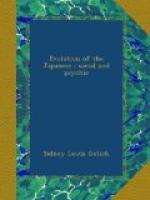In regard to the future life, Shinto has little specific doctrine. It certainly implies the continued existence of the soul after death, as its ancestral worship shows, but its conception as to the future state is left vague in the extreme. Confucius purposely declined to teach anything on this point, and, in part, for this reason, it has been maintained that Confucianism cannot properly be called a religion. Buddhism brought to Japan an elaborate system of eschatological ideas, and so far as the common people of Japan have any conception of the future life, it may be attributed to Buddhistic teachings. Into their nature I need not inquire at any length. According to popular Buddhism, the future world, or more properly speaking, worlds (for there are ten of them, into any one of which a soul may be born either immediately or in the course of its future transmigrations), does not differ in any vital way from the present world. It is a world of material blessings or woes; the successive stages or worlds are graded one above the other in fantastic ways. Salvation consists in passing to higher grades of life, the final or perfect stage being paradise, which, once attained, can never be lost. Transmigration is universal, the period of life in each world being determined by the merits and demerits of the individual soul.
Here we must consider two widely used terms “ingwa” and “mei.” The first of these is Buddhistic and the other Confucianistic; though differing much in origin and meaning, yet in the end they amount to much the same thing. “Ingwa” is the law of cause and effect. According to the Buddhistic teaching, however, the “in,” or cause, is in one world, while the “gwa,” or effect, is in the other. The suffering, for instance, or any misfortune that overtakes one in this present life, is the “gwa” or effect of what was done in the previous, and is thus inevitable. The individual is working off in this life the “gwa” of his last life, and he is also working up the “in” of the next He is thus in a kind of vise. His present is absolutely determined for him by his past, and in turn is irrevocably fixing his future. Such is the Buddhistic “wheel of the law.” The common explanation of misfortune, sickness, or disease, or any calamity, is that it is the result of “ingwa,” and that there is, therefore, no help for it. The paralyzing nature of this conception on the development of character, or on activity of any kind, is apparent not only theoretically but actually. As an escape from the inexorable fatality of this scheme of thought, the Buddhist faith of the common people has resorted to magic. Magic prayers, consisting of a few mystic syllables of whose meaning the worshiper may be quite ignorant, are the means for overcoming the inexorableness of “ingwa,” both for this life and the next. “Namu Amida Butsu,” “Namu Myo Ho Ren Ge Kyo,” “Namu Hen Jo Kongo,” are the most common of such magic formulae. These prayers are heard




